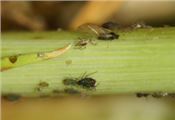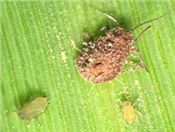Unnecessary Use Of Pyrethroids In Wheat Can Lead To Aphid Resistance And Barley Yellow Dwarf Virus Outbreaks
DR. RAUL VILLANUEVA
PRINCETON, KY.
In western Kentucky, wheat aphid monitoring has not detected the presence of this bug so far. This doesn’t mean that aphids are not in fields. They are out there at such low numbers that they cannot be detected through our sampling method. This outcome is different from the high populations recorded in the 2017 winter. The aphid decline might be the result of lower temperatures experienced this winter (versus the winter of 2017), and the continuous rains this year.
Kentucky’s Aphid Species
In Kentucky, there is a complex of aphid species that feeds on wheat. The most important are the bird cherry oat (Figure1), English grain, greenbug, and corn leaf aphids. Their role as vectors of Barley Yellow Dwarf Virus (BYDV), has branded them as key pests of wheat grain production. These aphid species overwinter as nymphs and can be active when temperatures are above 45ºF. It is known that BYDV infections are more damaging when they occur in early growth stages of wheat plant. Thus, aphids have more opportunities to infect young plants under this climatological circumstance (temperatures greater than 45° F).
Management
I have heard that many farmers, as well as personnel conducting research, have been spraying their wheat fields with pyrethroids during the last 2 weeks. This is done as a tank mix where herbicides and insecticides are applied together. Pyrethroid applications are made for two reasons: (1) as a preventive effort to reduce BYDV infections and (2) the low cost of this type of insecticide.
As an applied entomologist I would not have any objection to these applications; however, in many cases this tactic is completed without taking tallies of aphids in wheat fields. If aphids are not present, farmers are making some unnecessary expenditures and might be affecting natural enemies.
In 2017, we worked in two barley fields where pyrethroid sprays were applied twice in the fall of 2016 and at least three times between February and April 2017. Aphid populations were at least 20 fold above the threshold on wheat (greater than 10 aphids at more than 60 days post-emergence) when we visited these fields by late April. A possible case of aphid resistance to pyrethroids might had occurred in these fields; however, and epizootic entomopathogen (Figure 2) and aphid parasitoids wiped out the aphids in less than 2 weeks. Thus aphid resistance to pyrethroids was not verified in this case.
From my point of view, this year, farmers should consider restricting pyrethroid usage due to the low number of aphids. Also, the continuous rainfall occurring this spring might have been causing high aphid mortalities. Something that needs to be considered is that a temporary suspension on pyrethroid use early this spring could disrupt populations of aphids that might have developed pyrethroid resistance as they hybridize with populations without this resistance. Aphid resistance can lead to survival of aphids and outbreaks of BYDV.
All of this implies that aphid monitoring should be continued, and if tallies are above the threshold levels, a foliar insecticide application needs to be considered. ∆
DR. RAUL VILLANUEVA: Extension Entomologist, University of Kentucky

Figure 1. Several stages of bird cherry oat aphids

Figure 2. An adult aphid killed by an unidentified epizootic
entomopathogen. This entomopathogen wiped
out an aphid outbreak in 2017.
Photos: Yaziri Gonzales, UK